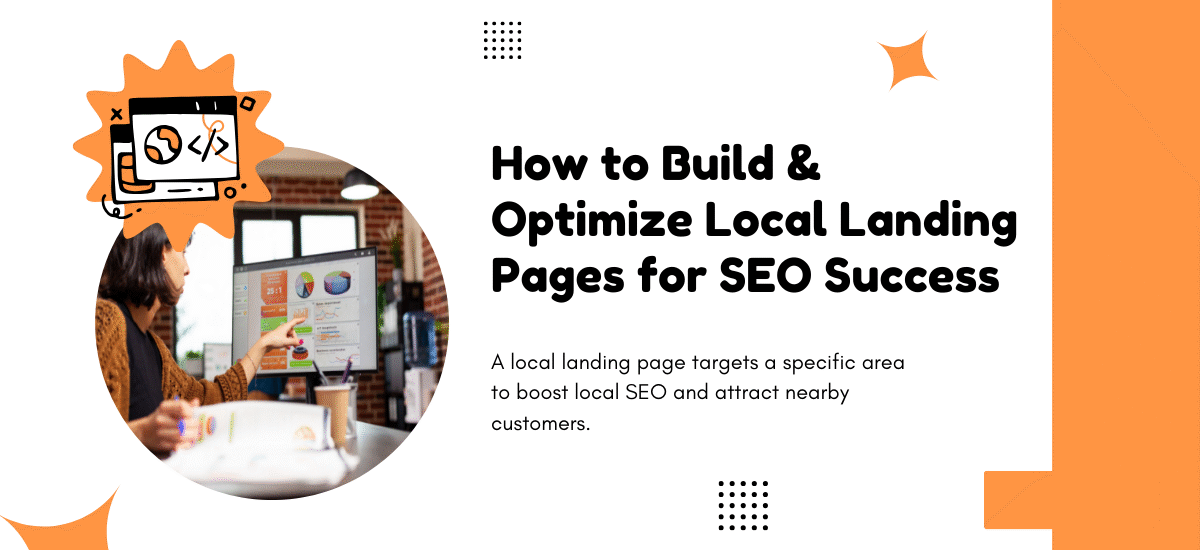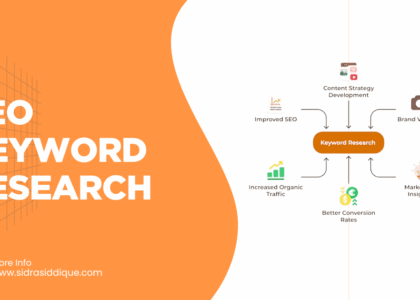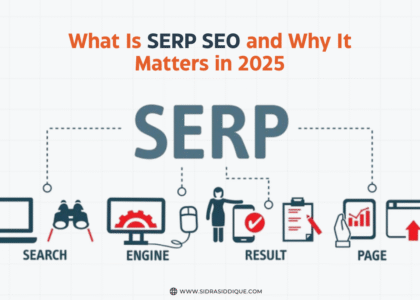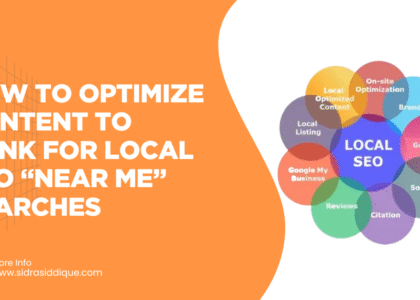Building strong local SEO landing pages is one of the most effective ways to attract nearby customers who are actively searching for services. Whether someone types “dentist in Dallas” or “restaurant near me,” a well-optimized page helps your business stand out in Google local search results.
By focusing on localized marketing, you can highlight your services, address, and unique offers to the right audience at the right time. Adding trust signals such as customer reviews and clear contact details makes your page even more powerful. With the right structure and strategy, optimized pages can drive conversions, increase visibility, and strengthen your online presence in competitive markets.
What Are Local Landing Pages?
A local landing page is a web page created to rank for a city or neighborhood. It combines service + location keywords such as “dentist in Dallas” or “dermatologist near me.” This makes it easier for people searching with nearby searches to find you. These pages are designed for localized marketing so they highlight your address, services, and contact details clearly.
Think of them as digital storefronts. Just like your physical location shows customers where to walk in, local SEO landing pages show Google and people exactly where you serve. Without them, your site may compete nationally, but you’ll miss those ready-to-buy local clicks.
Why Local Landing Pages Matter for SEO
Search engines want to give users results that match their intent. For local intent, Google Business Profile (GBP) and Google 3-Pack / local pack dominate. Right under that, you’ll see organic search results where local landing pages shine.
A Localized Marketing Benchmark Report (2022) found that top local businesses enjoyed a 612% surge in traffic and a 397% increase in actions. A page ranking in the top position can gain a 27.6% click-through rate, which translates to real leads and revenue.
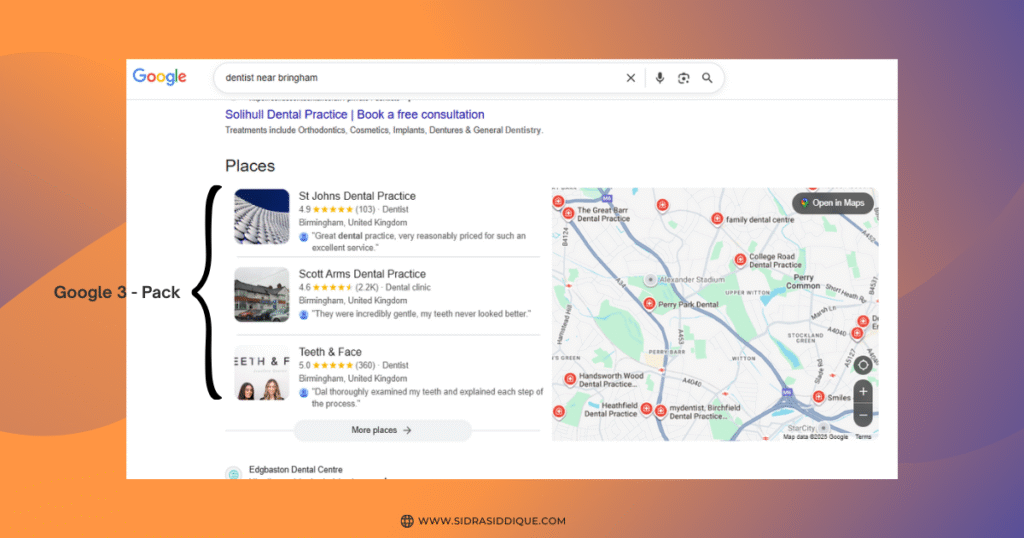
Local Landing Pages vs. Google Business Profiles
Many business owners confuse local landing pages with Google Business Profile listings. The truth is, they work together. A Google Business Profile helps you appear in Google Maps and the local pack, but it doesn’t replace an optimized landing page.
Your landing page supports your GBP by providing detailed content, schema markup, and trust-building elements like local testimonials. When both are optimized, you increase your chances of showing up in near me searches and attracting more conversions.
Which Businesses Should Use Local Landing Pages?
Every business with a local presence in the U.S. should use them. A single-location bakery in Boston can build one page, while a chain of gyms across Chicago can have many. Even service providers without storefronts, such as electricians or lawyers, gain visibility with local SEO landing pages.
National brands can also benefit by creating state or city-specific pages. Instead of one generic service page, localized marketing allows each location to connect with its own audience. This makes it easier to win trust from people who want services close to home.
Key Benefits of Local Landing Pages
Improved Local SEO
A page optimized with structured data, URL structure, and meta tags will appear in Google local search for service + location keywords.
More Leads & Conversions
Strong call-to-action (CTA) buttons such as “Call Now” or “Get Directions” encourage instant action.
Better Customer Experience
Visitors see hours, services, and local pricing without confusion. Fast page speed optimization ensures smoother browsing.
Stronger Online Reputation
Displaying customer reviews and local testimonials builds credibility. It also sends freshness signals to Google, improving authority.
Essential Elements of an Effective Local Landing Page
The success of local SEO landing pages depends on how they are built. A clean SEO-friendly URL, such as yourdomain.com/houston-dentist/, signals location clearly. Using optimized title tags & meta descriptions ensures that your listing looks clickable in search results.
Above the fold, include a headline with service + location keywords, a subheadline for detail, and a strong CTA button. Add localized images of your storefront or staff, embed a Google Map, and display NAP consistency. Reinforce with local reviews, pricing, internal links, and regional offers.
| Essential Element | Why It Matters |
| Localized URL | Improves visibility in Google search |
| Meta Tags | Increase CTR and keyword targeting |
| Maps & NAP | Ensure consistency with Google Business Profile |
| Reviews | Provide social proof and trust |
| Local Pricing | Builds transparency for conversions |
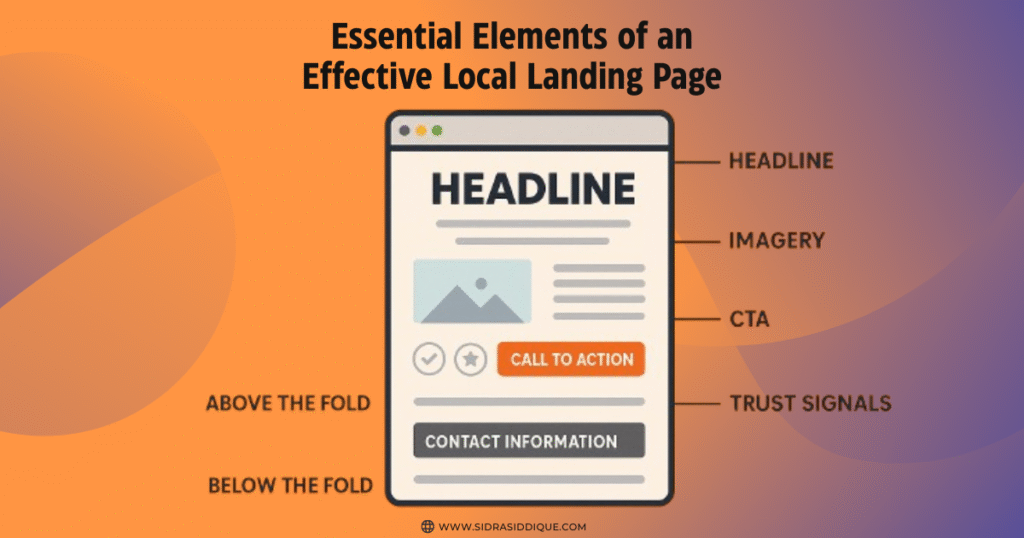
How to Build Local Landing Pages Step by Step
The process starts by knowing your audience. With GA4 (Google Analytics 4), you can see which cities or states send traffic to your site. This makes it easy to plan pages that answer local demand.
The next step is keyword research for each location. Phrases like “dermatologist in Dallas Texas” are easier to rank than generic terms. Once you have keywords, write meta tags, add LocalBusiness schema, and create personalized CTAs. Introduce your local team with bios, upload videos or even a 360° tour of your office. This builds trust and keeps people on your page longer.
How to Optimize Local Landing Pages for SEO
Optimization ensures that your hard work pays off. Start with mobile-first design because more than 60% of searches come from phones. Combine it with page speed optimization and SSL encryption for security.
Images should include alt tags and descriptive filenames. Avoid duplicate content or doorway pages. Focus on backlink building for local SEO by partnering with community websites. Track performance with analytics and do A/B testing on your CTAs, layouts, and images to see what works best.
How Local Landing Pages & Google Business Profiles Work Together
Your Google Business Profile should always link to your local landing page. This connection increases your Google Maps visibility and builds authority. When you keep NAP consistency across both, search engines reward you with higher trust.
For multi-location companies, each branch should have its own GBP connected to its own landing page. This avoids confusion and helps businesses dominate across multiple cities at once. Together, GBP and local landing pages form a complete local SEO system.
Advanced Local Landing Page Strategies
As competition grows in U.S. cities, you need strategies beyond the basics. Add community calendars showing local events your business supports. Encourage user-generated content like customer photos or tagged Instagram posts. Highlight staff with bio pages that connect them to the local community.
Brands such as Shewin and ClockShark have seen success using structured data and customer content. By connecting landing pages to store locators, businesses make it easier for users to find the closest location in seconds.
How Many Landing Pages Should You Create?
The number depends on competition. In smaller towns, one page per service area is often enough. In highly competitive cities like Los Angeles or New York, businesses may need multiple pages targeting neighborhoods.The rule is simple: each location that matters deserves its own local SEO landing page. This ensures full coverage across regions without overstuffing a single page.
Examples of High-Performing Local Landing Pages
A dental clinic in Houston built a mobile-friendly landing page with a video introduction, customer reviews, and a “Book Appointment” CTA button. Within three months, organic leads grew by 40%.
Another case comes from a Milwaukee law firm. After fixing NAP inconsistencies and adding schema markup, they saw a 37% boost in local visibility and moved from #7 to #3 in the Google 3-Pack.
FAQs About Local Landing Pages
1. What are local landing pages?
Local landing pages are web pages built to target a specific location or service area. They help businesses rank in Google local search and attract customers from “near me” searches.
2. Is local SEO still relevant?
Yes, local SEO is more important than ever. With most searches happening on mobile, showing up in the Google 3-Pack can drive real leads and sales.
3. Can you do SEO on a landing page?
Absolutely. By optimizing meta tags, URL structure, schema markup, and adding customer reviews, a landing page can rank well locally.
4. Can I do local SEO myself?
Yes, you can start local SEO yourself with basic steps like keyword research, optimizing your Google Business Profile, and building local citations.
Final Thoughts & Next Steps
Mastering how to build & optimize local landing pages for SEO success is not just about ranking higher. It is about building trust with nearby customers, showing them relevant offers, and making their journey easy. Businesses that invest in mobile optimization, social proof, and structured data consistently outperform those that ignore local SEO.
If you want results faster, agencies like Apexure have built hundreds of conversion-focused landing pages across the U.S. With the right strategy, your brand can dominate local search, attract more leads, and build stronger relationships in every city you serve.

